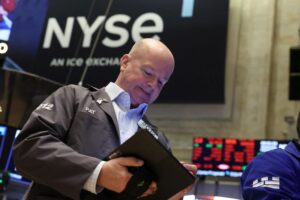The Volatility of U.S. Interest Rate Options: A Closer Look
In recent weeks, the landscape of U.S. interest rate options has taken a significant turn, revealing how investors are adjusting their strategies in response to economic uncertainties. As the market reacts to potential shifts in monetary policy, the nascent demand for specific swaptions—options on interest rate swaps—has surged, leading many analysts to draw their own conclusions about the future of economic growth in the U.S.
Swaptions: A Tool for Hedging or Speculating?
As the market braces for a potential slowdown, it’s essential to understand what’s driving the heightened interest in receiver swaptions. These instruments allow investors to receive fixed cash flows while paying a variable rate, effectively betting on a decrease in interest rates. The increased transactional volume, which approached an impressive $700 billion in late February, signals that traders are not only hedging against risks but are also positioning themselves for a possible significant economic downturn.
Interestingly, this uptick in demand starkly contrasts the sentiment prior to the inauguration of President Trump. At that time, traders were more focused on scenarios involving rate tightening due to anticipated fiscal policies, such as increased tariffs and spending plans. Now, the sentiment in the options market reflects a precautionary stance, indicating a shift as investors recalibrate their expectations.
A Shift in Economic Outlook
The current landscape reveals an intriguing divergence in sentiment between various market players. While some remain mildly optimistic, bolstered by positive economic indicators, others are expressing grave concerns over the potential for a pronounced economic deceleration. Guneet Dhingra, head of U.S. rates strategy at BNP Paribas, highlights that the options market is pricing in a higher probability of drastic rate cuts. This isn’t merely speculative; such positioning follows market tremors, such as the fall of Silicon Valley Bank, which only amplified fears surrounding systemic vulnerabilities.
The implications are significant. With President Trump’s trade policies raising inflation concerns, there is growing anxiety about the potential for a hard landing for the U.S. economy. While the prospect of a recession has been publicly downplayed by the administration, the palpable tension in the derivatives market suggests otherwise.
The Importance of Tail-Risk Pricing
Investors are increasingly willing to pay premiums for protection against what are known as "tail risks." Recent data indicates that the cost of safeguarding against an extreme scenario, such as a 100 basis point drop in swap rates, has surged. This is critical because historically, significant drops in swap rates often correlate with aggressive policy easing by central banks. The current federal funds rate hangs at 4.33%, and an unexpected shift could shake the foundations of the financial markets.
While predictions of a 100 basis point reduction remain speculative, the market’s positioning indicates that players are ready for extreme outcomes. In fact, some investors are preparing for scenarios that involve a drop of 100 to 150 basis points within a single year. This approach illustrates not just caution but a potential preparedness for strategic adjustments based on evolving economic conditions.
Rising Volatility: The Key Component
The correlation between rising implied volatility and increasing demand for protection cannot be overlooked. The implied volatility of one-month options on one-year swap rates recently hit a four-month high, demonstrating an elevated perception of risk among investors. As Srini Ramaswamy from J.P. Morgan points out, the duality created by ongoing tariff negotiations and geopolitical tensions fuels uncertainty in the market. As volatility rises, so too does the risk premium, meaning investors are bracing for the unexpected.
Final Thoughts
Understanding the dynamics at play in the U.S. interest rate options market is essential for both hedgers and speculators alike. As we peer into the future, it’s evident that the sentiment among traders reflects not only immediate reactions to current events but also a deeper concern for what lies ahead. The evolution of economic policy, coupled with unpredictable geopolitical landscapes, has created a multifaceted risk environment that investors must navigate with care.
At Extreme Investor Network, we emphasize the importance of both current market dynamics and the potential for future shifts. Our team is dedicated to providing insightful analysis tailored specifically for today’s investors looking to capitalize on opportunities while managing risk effectively. Stay informed and prepared as we continue to monitor these trends.

